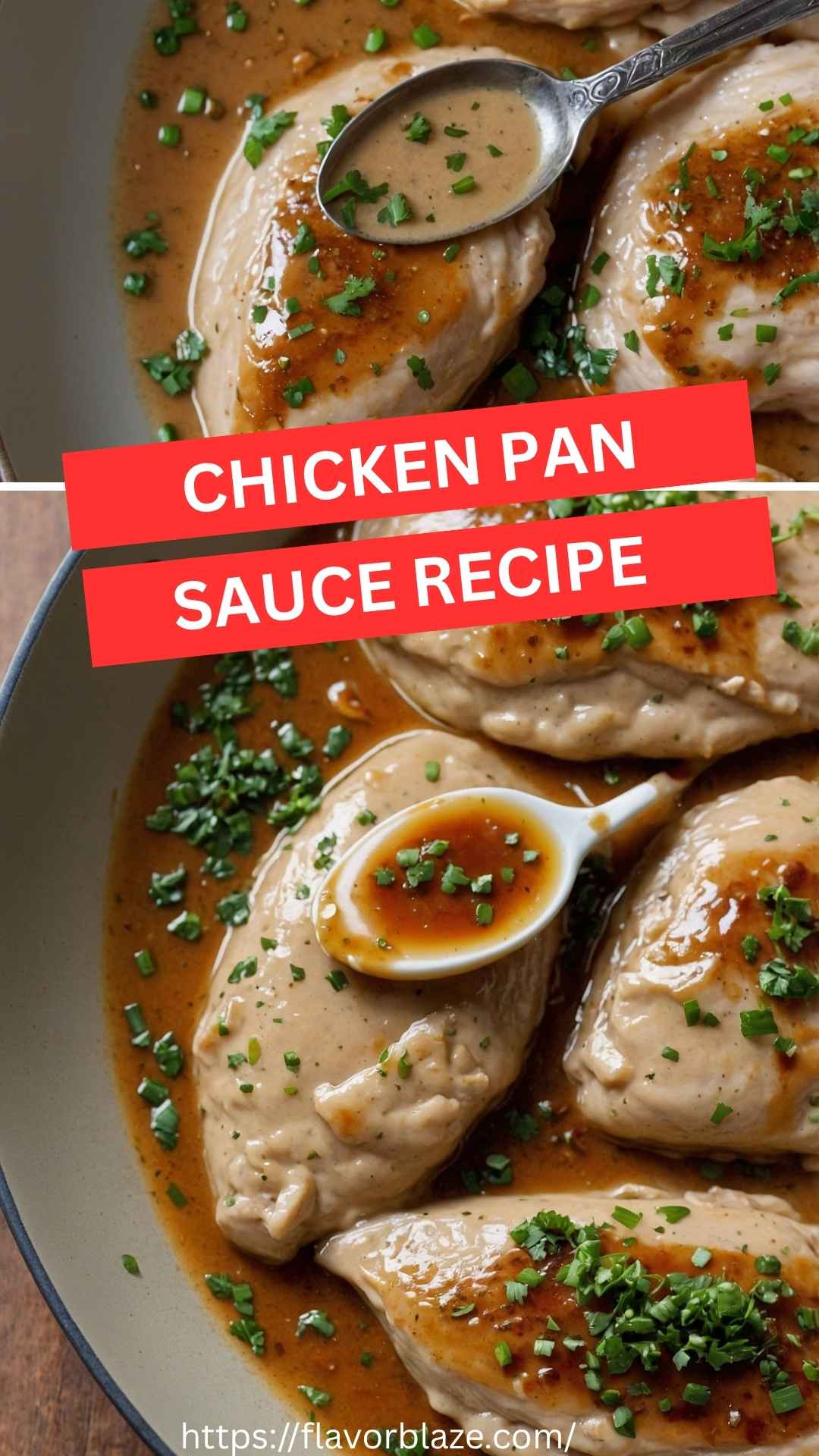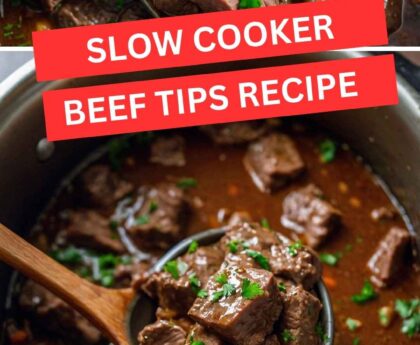Before diving into the delightful world of chicken pan sauce, let’s chat about side dishes that can elevate your meal. This sauce is a superstar and can partner beautifully with a variety of companion dishes.
Picture creamy mashed potatoes soaking up every glorious spoonful of that sauce. Or imagine it drizzling over a bed of fluffy rice, playing off the subtle richness. Vegetables can also shine alongside this dish.
A simple sautéed green bean medley or roasted Brussels sprouts could bring a vibrant crunch to the table. And if you’re feeling Italian, why not serve it over a bed of al dente pasta? Your taste buds will be thanking you.
Now, let’s get into the nitty-gritty of that incredible chicken pan sauce recipe.
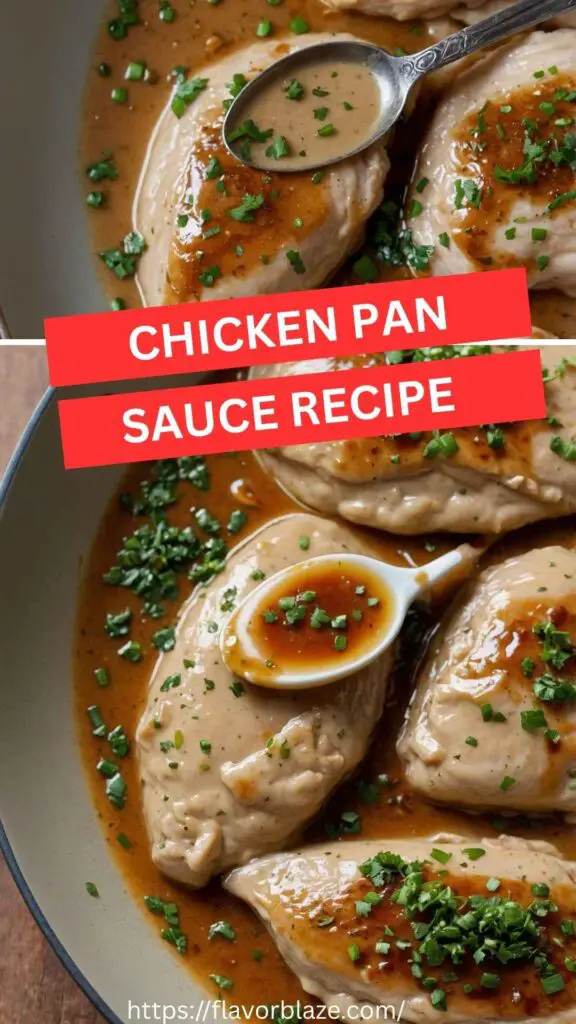
You’ll Also Like These Recipes
Hello, kitchen adventurers! Let’s talk about something that can transform your chicken dinner into a restaurant-quality experience without needing a culinary degree. We’re referring to the chicken pan sauce. It’s the culinary magic that happens in the skillet after you cook your chicken to perfection.
I can already hear you thinking, “How can I possibly replicate the deliciousness I’ve tasted?” I assure you, it’s easier than it sounds. This chicken pan sauce recipe will elevate any ordinary chicken breast into an extraordinary meal bursting with flavor.
So, why bother with a pan sauce? In my kitchen explorations, I’ve realized that all great dishes have layers of flavor that come together harmoniously.
A pan sauce is not just a sauce; it’s essentially the essence of the chicken and its cooking juices, combined with flavorful ingredients that create something truly delicious. So, let’s roll up our sleeves and dive into making this drool-worthy dish.
What is Chicken Pan Sauce?
In its simplest form, chicken pan sauce is made by deglazing the remnants of cooked chicken. After frying or sautéing your chicken, you’ll notice bits of flavor clinging to the pan. This is your pot of gold, my friends.
A pan sauce involves adding a flavorful liquid—often broth and wine—to that pan after you’ve removed the chicken, scraping up those delectable browned bits and creating a rich sauce. It’s quick, it’s easy, and honestly, it’s hard to resist!
What is the Flavor Profile of This Dish?
The flavor profile of a chicken pan sauce is complex yet comforting. You’ll find savory notes from the chicken, earthiness from garlic, a bright acidity from the Dijon mustard, and a hint of sweetness from shallots. Toss in a blend of herbs, and you’ve got yourself a sauce that’s tangy, savory, and utterly irresistible. If your taste buds are craving something vibrant and fresh, this is it. Each component adds to the harmony and elevates your meal.
Why You’ll Love This
Why will you love this chicken pan sauce? It’s simple.
1. It takes minimal time to prepare, allowing you to serve a delicious meal without spending hours in the kitchen.
2. It’s versatile. Whether you’re pairing it with roasted vegetables, pasta, or rice, it fits seamlessly into any meal.
3. It’s nutritious. With fresh ingredients and no heavy cream, you can indulge guilt-free.
4. The satisfaction of making a homemade sauce that rivals restaurant-quality offerings is unmatched.
Ingredients
1. 1 teaspoon freshly minced garlic
2. 2 tablespoons unsalted butter, divided
3. Kosher salt and freshly cracked black pepper, to taste
4. 2 teaspoons Italian herb seasoning blend, divided
5. 1 teaspoon Dijon mustard
6. ¼ cup finely minced shallots
7. 2 pounds boneless, skinless chicken breasts, pounded evenly to ½-inch thickness
8. 2 tablespoons light olive oil
9. 1 ½ cups low-sodium chicken broth (or substitute with 1 cup dry white wine)
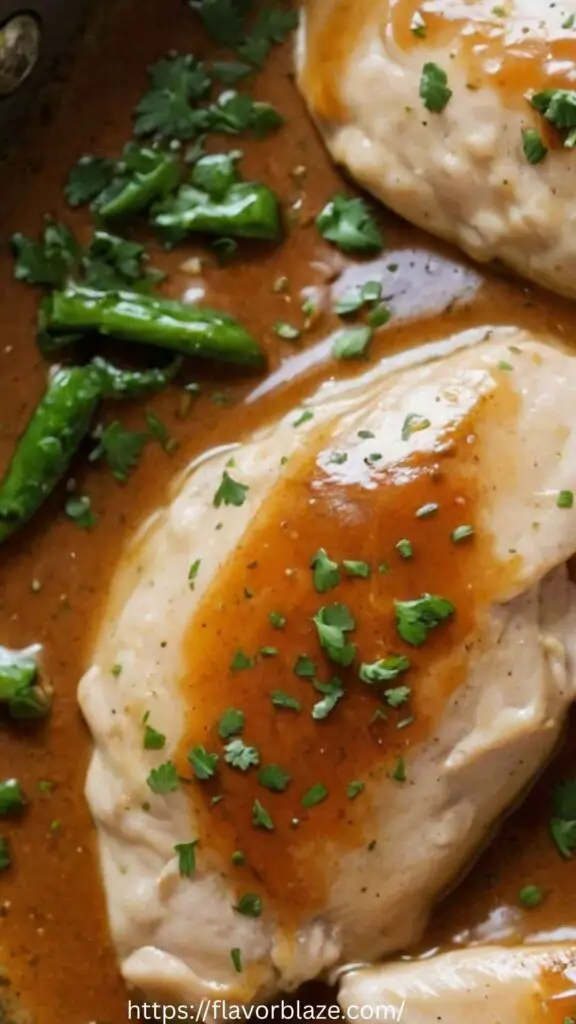
Step by Step Instructions
Step 1: Prepare the Chicken
Start by preparing your chicken breasts. Pat them dry with paper towels to remove excess moisture—this helps achieve a nice sear. Season the chicken breasts on both sides with kosher salt, freshly cracked black pepper, and one teaspoon of the Italian herb seasoning. Make sure you coat them evenly.
Step 2: Sear the Chicken
Heat a large skillet over medium-high heat. Add the light olive oil and let it get hot. When the oil shimmers, carefully add the seasoned chicken breasts to the skillet. Sear them for about 5–7 minutes on one side without moving them.
This allows a nice golden crust to form. Flip the chicken and sear for an additional 5–7 minutes on the other side until the chicken is cooked through. Use a meat thermometer if you need—chicken should reach an internal temperature of 165°F.
Step 3: Remove the Chicken
Once the chicken is cooked, transfer it to a plate and cover it loosely with foil to keep it warm. Don’t clean the skillet; instead, let those flavorful bits hang around for the sauce.
Step 4: Sauté Shallots and Garlic
Now, let’s add flavor! In the same skillet, reduce the heat to medium. Add one tablespoon of butter and let it melt.
Toss in the minced shallots and sauté them for about 2–3 minutes until they become translucent. Stir in the minced garlic and cook for another 30 seconds, just until fragrant. Be careful not to burn the garlic; it can turn bitter quickly.
Step 5: Deglaze the Pan
Next, it’s time to deglaze the pan. Pour in the low-sodium chicken broth (or white wine), scraping up all those little bits of heaven from the bottom of the skillet with a wooden spoon. Keep stirring to incorporate the flavors. Allow the mixture to simmer for about 4–5 minutes until it reduces slightly.
Step 6: Finish the Sauce
Once the sauce has reduced, add the Dijon mustard and remaining one tablespoon of butter. Whisk everything together until the butter is melted and the sauce is well combined. Season with the remaining teaspoon of Italian herb seasoning, salt, and pepper to taste.
Step 7: Serve
To serve, place the chicken breasts on a plate and generously spoon the pan sauce over the top. Feel free to garnish with fresh herbs like parsley or thyme if you have them on hand.
Tips & Tricks
– Use a heavy skillet: A skillet that retains heat well, such as cast iron or stainless steel, helps achieve the best sear.
– Don’t overcrowd the pan: If you have too much chicken, you might steam rather than sear. Cook in batches if necessary.
– Experiment with flavors: Feel free to mix in a splash of lemon juice or a bit of cream for a different flavor profile.
– Make it ahead: You can make the sauce ahead of time and reheat it before serving. Just add a bit of broth to loosen it up if it thickens too much.
– Don’t waste any flavor: If you have leftover sauce, use it with veggies or grains to minimize waste.
Nutrition Information
This chicken pan sauce recipe serves approximately six. Each serving has:
– Calories: 280
– Protein: 35g
– Carbohydrates: 4g
– Fat: 12g
– Fiber: 0g
This is a nutritious option that fits well into most diets, providing ample protein and flavor without excess calories.
How Can You Store This Chicken Pan Sauce Recipe?
If you find yourself with leftovers, don’t fret! Store any remaining sauce in an airtight container in the refrigerator for up to 3 days. When reheating, add a splash of chicken broth to restore its creamy consistency. If you want to freeze the sauce, it can last in an airtight container or freezer bag for up to 3 months.
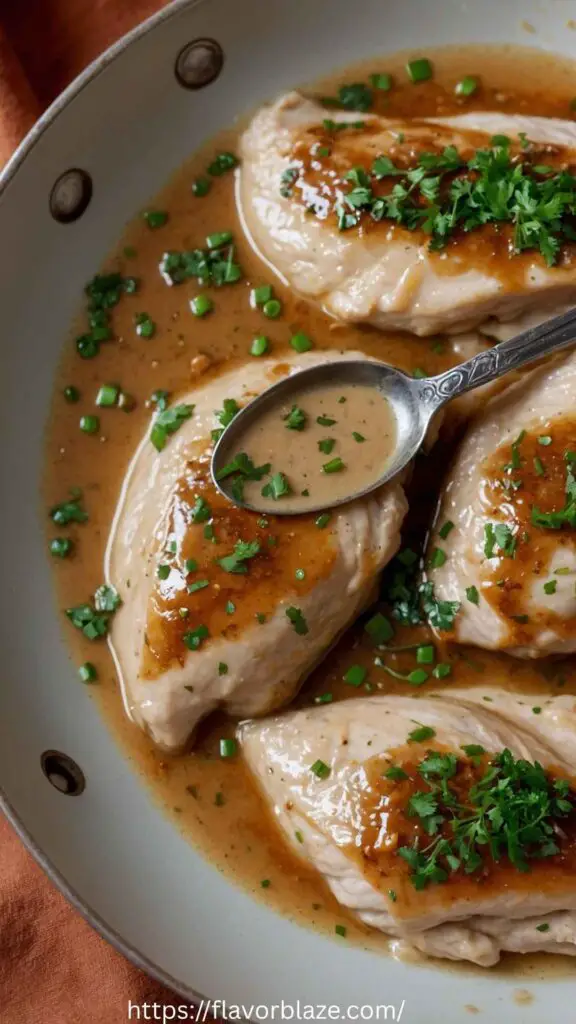
Alternative Ingredient Choices
Don’t have all the ingredients? No problem! Here are three alternatives:
– No shallots? Use finely chopped onions instead. Green onions can work, too, for a milder flavor.
– Chicken broth missing? You could use vegetable broth or even water with a sprinkle of salt and herbs. It won’t be as rich, but it will still work fine.
– Out of Dijon mustard? Try using whole grain mustard or even a splash of apple cider vinegar mixed with a tiny bit of honey for similar flavors.
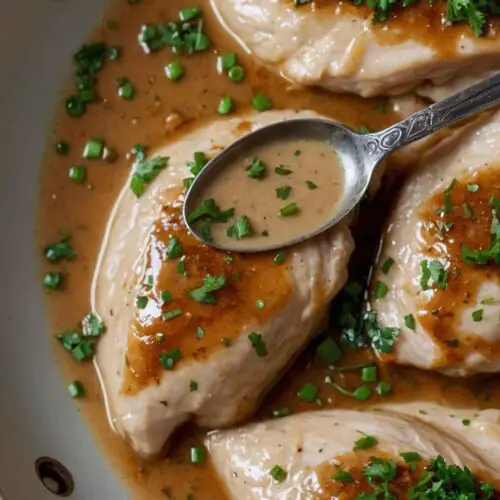
Chicken Pan Sauce
Equipment
- Skillet, Tablespoons
Ingredients
- 1 teaspoon freshly minced garlic
- 2 tablespoons unsalted butter divided
- Kosher salt and freshly cracked black pepper to taste
- 2 teaspoons Italian herb seasoning blend divided
- 1 teaspoon Dijon mustard
- ¼ cup finely minced shallots
- 2 pounds boneless skinless chicken breasts, pounded evenly to ½-inch thickness
- 2 tablespoons light olive oil
- 1 ½ cups low-sodium chicken broth or substitute with 1 cup dry white wine
Instructions
Step 1: Prepare the Chicken
- Start by preparing your chicken breasts. Pat them dry with paper towels to remove excess moisture—this helps achieve a nice sear. Season the chicken breasts on both sides with kosher salt, freshly cracked black pepper, and one teaspoon of the Italian herb seasoning. Make sure you coat them evenly.
Step 2: Sear the Chicken
- Heat a large skillet over medium-high heat. Add the light olive oil and let it get hot. When the oil shimmers, carefully add the seasoned chicken breasts to the skillet. Sear them for about 5–7 minutes on one side without moving them.
- This allows a nice golden crust to form. Flip the chicken and sear for an additional 5–7 minutes on the other side until the chicken is cooked through. Use a meat thermometer if you need—chicken should reach an internal temperature of 165°F.
Step 3: Remove the Chicken
- Once the chicken is cooked, transfer it to a plate and cover it loosely with foil to keep it warm. Don’t clean the skillet; instead, let those flavorful bits hang around for the sauce.
Step 4: Sauté Shallots and Garlic
- Now, let’s add flavor! In the same skillet, reduce the heat to medium. Add one tablespoon of butter and let it melt.
- Toss in the minced shallots and sauté them for about 2–3 minutes until they become translucent. Stir in the minced garlic and cook for another 30 seconds, just until fragrant. Be careful not to burn the garlic; it can turn bitter quickly.
Step 5: Deglaze the Pan
- Next, it’s time to deglaze the pan. Pour in the low-sodium chicken broth (or white wine), scraping up all those little bits of heaven from the bottom of the skillet with a wooden spoon. Keep stirring to incorporate the flavors. Allow the mixture to simmer for about 4–5 minutes until it reduces slightly.
Step 6: Finish the Sauce
- Once the sauce has reduced, add the Dijon mustard and remaining one tablespoon of butter. Whisk everything together until the butter is melted and the sauce is well combined. Season with the remaining teaspoon of Italian herb seasoning, salt, and pepper to taste.
Step 7: Serve
- To serve, place the chicken breasts on a plate and generously spoon the pan sauce over the top. Feel free to garnish with fresh herbs like parsley or thyme if you have them on hand.
Notes
– Don’t overcrowd the pan: If you have too much chicken, you might steam rather than sear. Cook in batches if necessary.
– Experiment with flavors: Feel free to mix in a splash of lemon juice or a bit of cream for a different flavor profile.
– Make it ahead: You can make the sauce ahead of time and reheat it before serving. Just add a bit of broth to loosen it up if it thickens too much.
– Don’t waste any flavor: If you have leftover sauce, use it with veggies or grains to minimize waste.
Nutrition
Frequently Asked Questions
1. Can I use chicken thighs instead of breasts?
Absolutely! Chicken thighs add richness and can add more flavor due to their fat content. Just be sure to adjust cooking times, as thighs may take a little longer.
2. Can I make this sauce without alcohol?
Yes! If you prefer not to use wine, stick with chicken broth or flavored vinegar. Just remember to adjust for taste.
3. Is this recipe suitable for meal prep?
Yes, this recipe is perfect for meal prep! Cook the chicken and sauce, and divide them into meal containers. It reheats beautifully.
4. What herbs can I use instead of Italian seasoning?
Feel free to mix and match! Herbs like rosemary, thyme, or oregano can add wonderful flavor. Just adjust amounts based on your preference.
5. Can I add vegetables to the sauce?
Of course! Sautéed mushrooms, spinach, or even diced tomatoes can enhance your sauce. Just add them in when cooking the shallots.
Conclusion
And there you have it! A delightful chicken pan sauce that quickly elevates your dinner from mundane to magnificent. With a few simple ingredients and some straightforward steps, you can bring a little piece of culinary heaven to your table.
This is not just a recipe; it’s a gateway to more satisfying meals filled with layers of flavor. Remember, the best meals are made with love and a dash of creativity. So, grab your skillet, unleash your inner chef, and enjoy the journey! Happy cooking!

